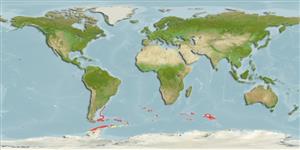Common names from other countries
Classification / Names / Names
ماع يماسا | فدارتم | Catalog of Fishes (gen., sp.) | ITIS | CoL | WoRMS
Environment: milieu / climate zone / depth range / distribution range
يسانش موب
یز حطس; قمع تارييغت 487 - 765 m (Ref. 58893). Subtropical; 36°S - 70°S, 180°W - 174°E (Ref. 275)
Southern Ocean. Circumpolar.
Length at first maturity / Size / Weight / نس
Maturity: Lm ? range ? - ? cm Max length : 45.0 cm ML يسنج صاوخ نودب / رن سنج; (Ref. 106358)
Oceanic (Refs. 97142, 98471). Mesopelagic and bathyal. Adults occur in deeper waters and captured by seals and sea lions (Ref. 97142). Heavily preyed upon by sperm whales and seabirds. Diet includes krill and finfish (Ref. 98471).
Life cycle and mating behavior
غولب | لثم دیلوت | یزیر مخت | اه مخت | Fecundity | )ورال ( دازوت
Members of the class Cephalopoda are gonochoric. Male and female adults usually die shortly after spawning and brooding, respectively. Mating behavior: Males perform various displays to attract potential females for copulation. During copulation, male grasp the female and inserts the hectocotylus into the female's mantle cavity where fertilization usually occurs. Life cycle: Embryos hatch into planktonic stage and live for some time before they grow larger and take up a benthic existence as adults.
یلصا ذخآم
عجارم | هدننك گنهامه | ناراكمه
Roper, C.F.E., M.J. Sweeney and C.E. Nauen. 1984. (Ref. 275)
NCUI زمرق تسرهف رد تيعضو (Ref. 130435)
ستياس رظن زا تيعضو (Ref. 108899)
Not Evaluated
Not Evaluated
یناسنا هدافتسا
تاليش – يريگ يهام: هوقلاب هقالع
| FishSource |
اهرازبا
رتشيب تاعالطا
Age/Size
دشر
نزو - لوط
لوط - لوط
يسانش تخير
)ورال ( دازوت
يناوارف
يتنرتنيا عبانم
Estimates based on models
Preferred temperature
(Ref.
115969): 0.7 - 2.6, mean 2.1 (based on 33 cells).
یريذپ بيسآ
Low vulnerability (25 of 100).
